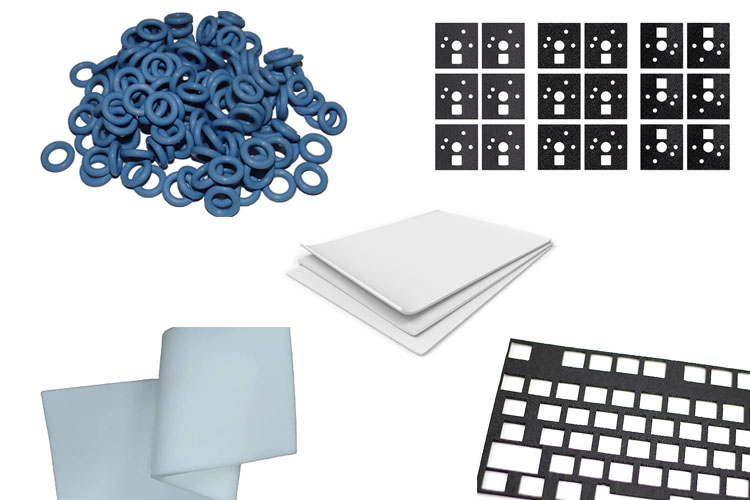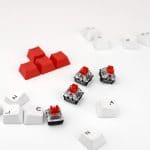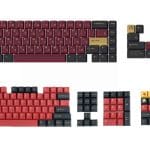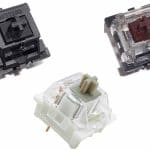With the increasing popularity of custom keyboards, many keyboard enthusiasts have developed different ways to improve their keyboards. The most popular mod that has become almost mandatory in almost keyboard build is the use of dampening materials. This mod originated as a DIY solution but was adapted in many retail mechanical keyboards.
Keyboard dampening materials play a big role in improving a keyboard’s sound and feel. They absorb any unwanted noise or vibration from various parts of the keyboard. Most enthusiasts apply dampening materials to the case and switches. Users can select what kind of dampening and material and where to apply them to get the best results.
Keyboard case and switch dampeners originated from DIY mods. Many users utilized pieces of recycled foam from the packaging of their keyboards to remove the hollow and pingy noise of early aluminum custom keyboards. Since then, many brands have adopted and refined this idea. They have also expanded dampening materials to other keyboard parts, such as the switches.
In this article, we will be learning about the different case and switch dampening materials used in most custom keyboard builds. And by the end of this article, you should be able to know what keyboard dampening materials are for and how to apply them in your custom keyboard build.
What are Keyboard Dampening Materials?
‘Keyboard dampening materials’ is the umbrella term used for any material that can absorb internal vibrations or noise inside your keyboard. Essentially, they are used to tune a keyboard’s sound or make them sound quieter. Dampening materials come in two types: switch dampeners and case dampeners.
Types of Keyboard Switch Dampeners
O-Ring Switch Dampener

Using O-ring switch dampeners is one of the easiest and most beginner-friendly ways to improve the sound of a keyboard. It only involves the user taking the keycaps out and placing the O-rings inside the unmounted keycaps.
These O-rings are typically made of silicone or rubber and are relatively easy to acquire. Adding to its ease is that it doesn’t require keyboard disassembly to carry out.
Many older prebuilt gaming keyboards utilized O-rings to make their keyboards sound quieter. But these days, O-rings are mainly used on stiff tray mount keyboards, such as the KBDFans Tofu, to simulate the bouncy and soft typing feel of gasket mount keyboards. Manufacturers also use O-rings to execute the burger mount/modified top mount.
PE Foam Switch Pads
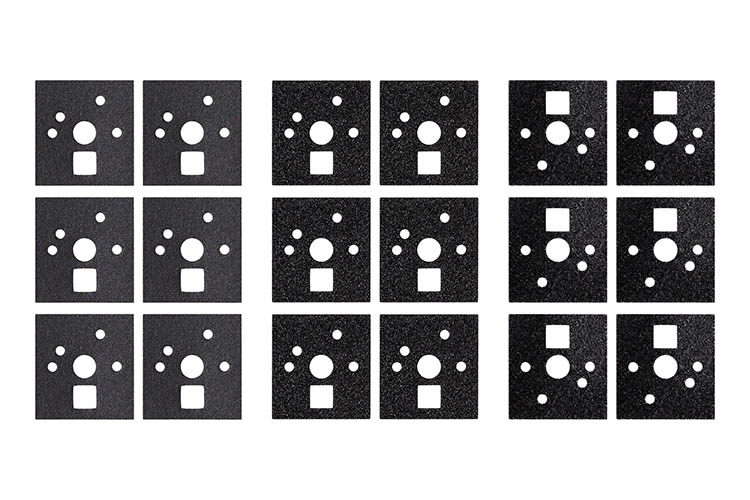
Enthusiasts who want a more advanced mod can utilize PE Foam switch pads. They essentially serve the same purpose as the full layer PE foam used on the PE Foam Mod.
However, they are easier to install since they come pre-cut, and all you need to do is to stick them to the PCB.
Unlike with O-rings, installing PE foam switch pads requires full disassembly. Therefore, this mod is best done before keyboard assembly for custom keyboards.
Keyboard Plate Foam
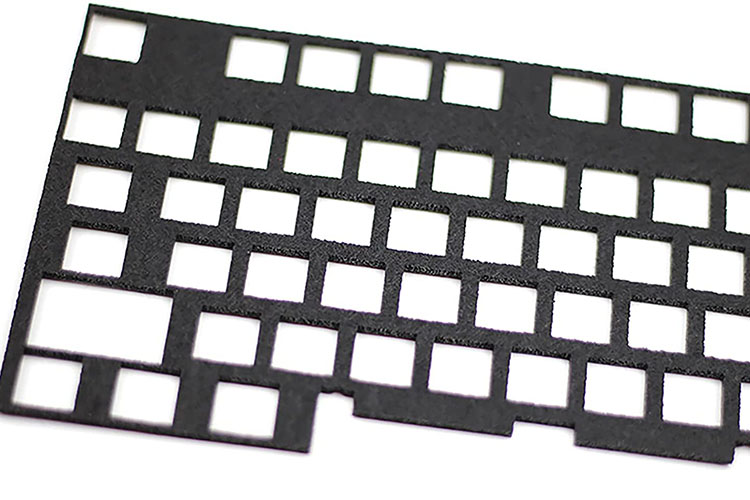
The final dampener for switches we will discuss is plate foam. Most plate foams use relatively thick foam with no pre-cut adhesive to fit your keyboard’s size. This mod is designed to absorb the sound that switches produce when they hit the plate.
Installing this foam allows the keyboard to sound quieter and cleaner. These dampeners can be easily removed or replaced if you dislike the mod.
Most keyboard manufacturers include plate foam for their keyboards. But if your keyboard kit does not come with one, many retailers offer third-party case foams.
Keyboard Case Dampeners
Case dampening foam is primarily used to improve a keyboard’s acoustics. More often than not, the presence of a hollow space in between a keyboard’s PCB and its case/chassis can make a board sound too high-pitched or “pingy.” This is especially true in aluminum cases, where the metal causes a loud keyboard reverb or echo.
In general, these keyboard dampening materials serve to better your keyboard’s sound signature. These dampeners fill the empty spaces in between keyboard parts. If you use keyboard sound dampening materials, your chosen material will evenly distribute the vibrations from your keystrokes. Thus, this mod results in a more well-balanced auditory experience while typing.
Types of Keyboard Case Dampeners
Technically, there are many kinds of keyboard case dampeners. But for this discussion, we will be narrowing it down to silicone and foam since they are the simplest and most effective solutions. Both of these options work to absorb vibrations that come from every keypress, producing a more solid and sonorous typing experience.
Foam
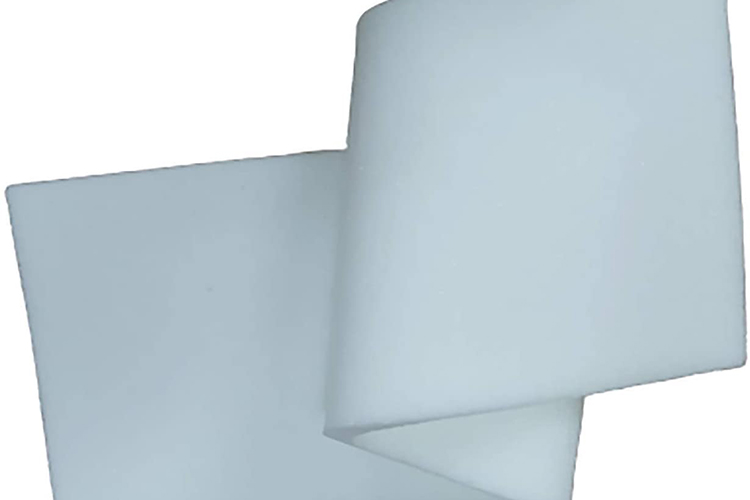
Dampening foam is the most common dampening material for keyboard cases, and some custom and prebuilt boards come with case foams. An example is the ever-famous Jelly Epoch Keyboard Kit, which comes with its own Case PORON Foam. The budget-friendly Next Time 75 Barebones Kit also comes assembled with its own polyethylene (PE) case foam.
Installing one is pretty easy for keyboards that do not come with a case foam. You can do this mod by cutting up pieces of foam to fit into your keyboard case.
For some boards, this may take two layers because there may be uneven case space when keyboards implement internal or external weights—because of this, using the foam dampening mod may look scuffed or less aesthetically pleasing. Alternatively, users can buy pre-cut foam from vendors such as KBDFans.
The keyboard case foram mod is far more accessible and less time-consuming to make compared to more complex mods such as the silicone dampening mod. There is also much more wiggle room for creativity in doing this modification because there are various types of foam that you can choose from, such as Sorbothane, neoprene, packing/PE foam, or even shelf liner. The foam dampening mod works similarly to the silicone dampening mod, dispersing the vibrations from keypresses more evenly than without a case dampening mod.
Silicone
![]()
The silicone mod for dampening keyboard case hollowness is a relatively recent modification, and it was conceptualized and done by YouTube user Serendipity. She uses the Tofu60’s keyboard case as a silicone mold, making sure to cover any holes and avoid screw standoffs so that she can safely screw the PCB back in place after making and placing the silicone sheet.
The silicone dampener works like a “shock absorber” of sorts. While pressing the keys on the keyboard, you would make vibrations that are then dispersed evenly throughout the silicone sheet when the mod is used. Thus, the keyboard would make a more sophisticated and muted sound.
If you’re interested in trying out this mod, be sure to purchase your own silicone-making kit as well as some protective equipment as a precautionary measure. Depending on the technique you choose to make your silicone sheet, you may also need tape, plastic wrap, and a dry-erase marker. In our dedicated article, you can learn more about the Silicone Mold Keyboard Mod.
Silicone Dampener vs. Dampening Foam for Keyboards
Both the silicone dampener and foam dampener mods have the same goal, and they are both designed to eliminate hollowness and any unwanted noise inside a keyboard. Ultimately, the better mod will be the one that best fits the user’s needs and their respective keyboard types.
The silicone dampening mod is more complex and time-consuming than case foams. In addition, there aren’t many companies offering pre-made silicone molds for custom keyboards. Also, more complex keyboard builds may not work well with the silicone dampening mod.
But with that said, the silicone dampening mod covers more surface area and allows RGB underglow to shine through the case. And for certain keyboards, the results are well worth the lengthy process of doing this mod.
On the other hand, Dampening foam is a lot easier and more accessible. Most keyboards come with case foam, and most vendors sell third-party foam for most custom keyboard models. Also, almost any custom or pre-built keyboard is compatible with this mod.
Of course, foam dampeners will not look as aesthetically pleasing as silicone molded keyboards, and they will certainly obstruct RGB underglow and will be seen on transparent keyboard cases. So to sum it up, pick the type of case dampener that best fits your custom keyboard build.
Why Use Keyboard Dampening Materials?
If you’re new to the mechanical keyboard hobby, you may be wondering: why spend more on mods when you’ve got a working keyboard already? Using keyboard dampening materials allows you to get the best sound your board has to offer.
Rather than spending thousands of bucks outright to get a robust full custom kit, you can choose to go the customization route through modding. You would then spend a little per modification you choose to implement. Moreover, playing with keyboard dampening materials opens a vast area of possibility for you to customize your keyboard.
How to Install a Foam Keyboard Case Dampener?
Installing keyboard case dampeners is one of the easier mods to undertake, especially if you have a solder-only PCB. This mod does not require desoldering and soldering back of switches.
Installing a keyboard case dampener requires you to take apart your keyboard to access the case, and the keyboard case dampener would be seated below the PCB. Most keyboard case dampener mods are straightforward, like the use of foam: you only need to cut the foam to fit your keyboard case properly and fill all the gaps. Others, like using a silicone sheet, require you to do more steps, such as mixing the DIY silicone kit and preparing the case that is going to be used as a mold.
Where to Get Keyboard Case and Switch Dampeners?
Many manufacturers offer pre-cut cases and switch dampeners. KBDFans, for instance, sells these kinds of accessories for their Tofu and KBD67 series keyboards. Stupidsifh also sells pre-cut foam for most of the popular custom keyboard kits. For keyboards that do not come with case forms or are not compatible with the ones in the market, users can take a DIY approach and make their own case and switch dampeners.
Stephen is the head content creator of Keyboardsexpert. His mechanical keyboard journey began in 2014 when he got his Razer Blackwidow. Since then, he has been fascinated with all things mechanical keyboard-related. He later discovered the custom keyboard hobby and fell in love with the vast customization options. He is currently searching for his endgame and is very excited to share his journey and educate other keyboard enthusiasts.
